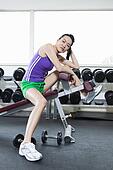Do you have fitness goals? Maybe it's to lose weight, or gain muscle, or run a 5k or even a marathon. Maybe it's to be consistent with your exercise routine; getting in 3-4 days of exercise per week each month. Or maybe your goal is to start eating healthier by eliminating foods that won't help you accomplish your ultimate goal. If any of these sound familiar, you're not alone.
I wrote a Blog a few months ago talking about setting SMART goals. This acronym refers to the following:
If you are not setting SMART goals then you are most likely wasting your time. I don;t mean for that to sound negative, but unless you have a plan how are you going to realistically accomplish that goal. You won't lose that 20 lbs. by sitting on the couch watching tv and eating chips. Or, making sure to exercise at least 3-4 days a week doesn't happen without a little planning to make sure you set aside time to complete it. More often than not, if your task (to exercise) is not listed on your calendar or on your I-Pod or on your smart phone, then odds are than something will "come up" and prevent you from getting in that 30-45 min. of sweating.
I often tell clients to write down your goals on a sticky note pad and place one at your office desk, one on your refrigerator, and one on the bathroom mirror. Those are location\s that you will see several times throughout the day and keep you constantly reminded of that goal.
Another helpful tool when setting goals is to let as many of your family and friends know what your goal is. The more people you know know what it is you are trying to accomplish, the more support you will get along the way as well as being held accountable.
When you accomplish a certain goal or goals don't stop there, think of a new one or two and set out to achieve them as well. We live on a planet where there are so many beautiful things to see and do, the healthier you are and longer you live, the more you will be able to see and do.
I wrote a Blog a few months ago talking about setting SMART goals. This acronym refers to the following:
If you are not setting SMART goals then you are most likely wasting your time. I don;t mean for that to sound negative, but unless you have a plan how are you going to realistically accomplish that goal. You won't lose that 20 lbs. by sitting on the couch watching tv and eating chips. Or, making sure to exercise at least 3-4 days a week doesn't happen without a little planning to make sure you set aside time to complete it. More often than not, if your task (to exercise) is not listed on your calendar or on your I-Pod or on your smart phone, then odds are than something will "come up" and prevent you from getting in that 30-45 min. of sweating.
I often tell clients to write down your goals on a sticky note pad and place one at your office desk, one on your refrigerator, and one on the bathroom mirror. Those are location\s that you will see several times throughout the day and keep you constantly reminded of that goal.
Another helpful tool when setting goals is to let as many of your family and friends know what your goal is. The more people you know know what it is you are trying to accomplish, the more support you will get along the way as well as being held accountable.
When you accomplish a certain goal or goals don't stop there, think of a new one or two and set out to achieve them as well. We live on a planet where there are so many beautiful things to see and do, the healthier you are and longer you live, the more you will be able to see and do.














